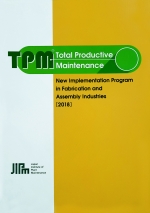This book explains, in an easily understandable manner, TPM procedures as they are currently implemented in the fabrication and assembly industries, and reflects throughout the guidance, expertise, and know-how of specialized consultants. For example, the book lists 16 major losses as factors that impede the efficiency of fabrication and assembly. With regard to specific improvements, the book explores programs for reducing seven major losses, such as "cutting blade losses," using up-to-date examples. Explanations of the eight pillars of TPM implementation, such as autonomous maintenance (Jishu-Hozen), quality maintenance, and maintenance, were modified to apply specifically to TPM for fabrication and assembly.
Introduction
Chapter 1 : Outline of TPM
-
1.1 : History of TPM and the Present State of Its Development
-
1.2 : Definition of TPM and Its Achievements
-
1.3 : Twelve Steps for the TPM Implementation Program
-
1.4 : Establishing the Preparatory System for the Introduction of TPM
-
1.5 : Outline from the Start of TPM Implementation to Its Established Stage
Chapter 2 : Concept of Improving Production Efficiency
-
2.1 : What is the Improvement of Production Efficiency?
-
2.2 : Sixteen Major Losses that can Impede Efficiency Improvement
-
2.3 : Structure of Losses
-
2.4 : Steps for Conducting Production Efficiency Improvement
-
2.5 : Comparison of Chronic Losses and Sporadic Losses
-
2.6 : Concepts of Improvement
Chapter 3 : Kobetsu-Kaizen for Enhancing Production Efficiency
-
3.1 : Improvement Program for Realizing Zero Failures
-
3.2 : Program for Improving Setup
-
3.3 : Improvement Program for Cutting-Blade Losses
-
3.4 : Improvement Program for Start-up Losses
-
3.5 : Improvement Program for Minor Stoppages
-
3.6 : Improvement Program for Reducing Speed Losses
-
3.7 : Program for Reducing Defects
Chapter 4 : Implementation of Jishu-Hozen Activities
-
4.1 : What is Jishu-Hozen?
-
4.2 : Concept of Implementing Jishu-Hozen
-
4.3 : Roles of Operation and Maintenance in Jishu-Hozen
-
4.4 : Concept of Creating Basic Conditions for Jishu-Hozen
-
4.5 : Step-by Step Implementation of Jishu-Hozen
-
4.6 : Jishu-Hozen Diagnosis
-
4.7 : Jishu-Hozen Implementation Master Plan and Target Setting
-
4.8 : Twelve Key Points in Successful Implementation of Jishu-Hozen
-
4.9 : Jishu-Hozen of the Assembly Line
Chapter 5 : Method of Conducting Planned Maintenance
-
5.1 : Basic Concept of Planned Maintenance
-
5.2 : Method of Conducting Planned Maintenance
-
5.3 : Seven Step Activities of Planned Maintanance
-
5.4 : Other Activities
-
5.5 : Study of Predictive Maintenance
Chapter 6 : Method of Carrying Out Initial-Phase Management
-
6.1 : Concept of LCC
-
6.2 : Concept of MP Design
-
6.3 : Procedure for Implementation of Initial-Phase Management Activities
-
6.4 : Method of Conducting Initial-Phase Product Management Activities
-
6.5 : Method of Conducting Initial-Phase Equipment Control Activities
-
6.6 : Method of Conducting Initial-Phase Production Flow Control
-
6.7 : Collection and Utilization of Product-Design Technology Information and MP-Design Information
Chapter 7 : Method of Conducting Quality Maintenance
-
7.1 : What is Quality Maintenance?
-
7.2 : Concept of Quality Maintenance Implementation
-
7.3 : Concentration of Inspection Items
-
7.4 : QM (Quality Maintenance) Matrix and Standardization
-
7.5 : Method of Conducting Quality Maintenance Training
Chapter 8 : Operation and Maintenance Skill Development
-
8.1 : Necessity of Operation and Maintenance Skill Development
-
8.2 : Basic Concept of Education and Training
-
8.3 : Six-Step Implementation for Operation and Maintenance Skill Development
Chapter 9 : Implementation of TPM in the Administrative and Indirect Departments
-
9.1 : Necessity of TPM in the Administrative and Indirect Departments
-
9.2 : Concept of TPM Activities of the Administrative and Indirect Departments
-
9.3 : Method of Implementing TPM in the Administrative and Indirect Departments
Chapter 10 : Establishment of Setups for Zero Accidents and Zero Pollution
-
10.1 : Safety/Health/Environmental Management and TPM
-
10.2 : Basic Concepts of Zero Accidents and Zero Pollution
-
10.3 : Priority Measures in Safety Management and Their Step Implementation
-
10.4 : Step Implementation of Safety Management
-
10.5 : Safety Management and MP Activities
-
10.6 : Ideal State of Safety Management
Chapter 11 : Small-Group Activities of TPM
-
11.1 : Characteristics of Small-Group Activities of TPM
-
11.2 : Purposes and Operation of TPM's Small-Group Activities
-
11.3 : Role of a Small Group in Each Echelon
Chapter 12 : Measurement of the Effectiveness of TPM
-
12.1 : Concept of Target-Setting
-
12.2 : Aims of Measuring the Effect of TPM Activities
Index

























